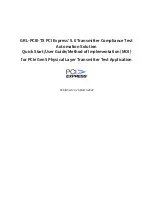
GRL-PCIE-TX Quick Start/User Guide/MOI
Rev1.0
© PCI-SIG 2022
Version 1.0, Mar 2022. Updated 03.26.2022
Page.
14
4
Testing Using GRL-PCIE-TX
The GRL-PCIE-TX test solution supports automated Tx compliance testing using the SigTest signal
quality/de-emphasis and stress tolerance analysis application for PCIe system board and add-in
card DUT’s. In a typical test environment, the
GRL-PCIE-TX automation software is run from the
PC/oscilloscope and communicates with the GRL-P1 hardware controller. This enables
automation control for the
DUT’s p
ower and signal quality test sequence, as well as waveform
acquisition for PCIe Gen5. Optionally an arbitrary function generator can also be used as an
alternative compliance toggle controller.
The GRL-P1 controller can be connected to either a PCI-SIG compliance load board (CLB) test
fixture for the system board DUT or compliance base board (CBB) test fixture for the add-in card
DUT. The GRL automation control enabled PC/Scope will send commands to GRL-P1 which
controls the power to the DUT and provides a compliance toggle signal to cause the DUT to enter
the next compliance state.
The DUT will transmit the test signal to the oscilloscope that is used to validate the test pattern of
the signal. The compliance signal will be captured and saved as a waveform file which is then
measured for stress tolerance and preset test compliance. In between, an optional RF switch can
be used and controlled by the GRL-PCIE-TX software to automate selection of the lane under test.
When testing is completed, the software will generate a test report detailing all results from all
lanes tested.
4.1
GRL-PCIE-TX Advantage
The GRL-PCIE-TX test solution provides a more efficient way to perform PCIe Tx compliance
testing rather than using traditional manually-driven methods that are generally both time-
consuming and error prone, tying up valuable equipment and resources.
To increase test efficiency, the GRL-P1 controller will first quickly capture waveforms on the
oscilloscope. Then using a separate computer, the GRL-PCIE-TX software will run PCIe compliance
tests for the waveforms, SigTest signal quality, and de-emphasis.
Through this offline processing of captured waveforms, the oscilloscope can be freed up for other
work. The test time can also be further reduced with t
he software’s multi
-threading of SigTest.
Another advantage is that GRL-P1 can be programmed to automatically capture only the
waveforms for the test that the user wants to perform.
4.2
Set Up DUT Tx Test with Automation
Once pre-configuration has been completed from Section 3.3, continue with the test setup. The
following procedures show how to set up the test environment to perform automated Tx
compliance testing for both the System Board and Add-
In Card DUT’s.





























